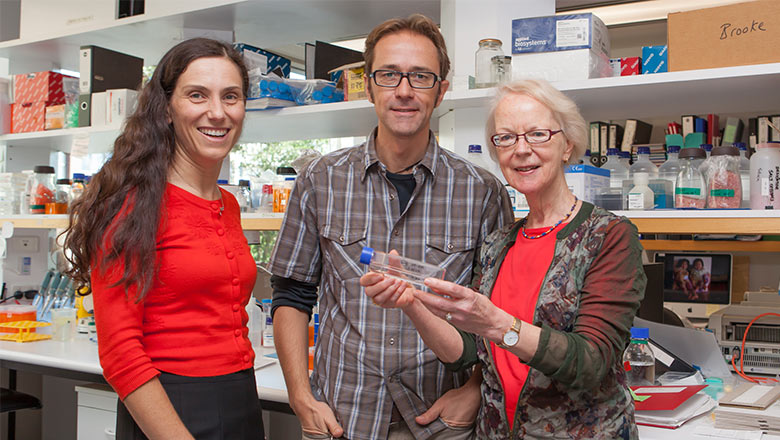Discoveries towards better treatments
When a local five-year-old boy was diagnosed with a particularly aggressive form of leukaemia, T-cell acute lymphoblastic leukaemia, The Kids Research Institute Australia researchers were among the team that discovered a critical chromosomal change in his cells never before reported.
Together with collaborators Professor Margaret Garson in Melbourne and Professor Terry Rabbitts in Cambridge, UK, they identified the HOX11 gene, found to be an important oncogenic driver in leukaemia.
“It is a master control gene, so when it is deregulated it changes a normal cell to a malignant cell, in combination with not-yet-understood additional changes,” said Institute researcher Professor Ursula Kees.
It was the early 1990s and Professor Kees had been working with the Princess Margaret Hospital Oncology Ward to improve understanding of childhood cancers and find better treatments.
“Our discovery changed thinking and led to many studies to decipher the mechanisms that lead to leukaemia,” Professor Kees said.
“Back then, we wanted to identify the genes at the chromosomal breakpoints. To do it, we collaborated with Professor Rabbitts in Cambridge.
“This work identified the HOX11 gene at the breakpoint and provided insight into the molecular events that lead to this critical change.”
It is now known that the HOX11 gene is permanently activated in the leukaemia cells and it drives the disease.
“In subsequent studies, we found that HOX11 activation is exclusive to T-cell acute lymphoblastic leukaemia (T-ALL) and does not occur in the more common form of B-lineage ALL, which about 80 per cent of childhood ALL patients have,” said Professor Kees.
“We also discovered that there must be other mechanisms, than chromosomal changes, that lead to activation of HOX11, and we studied the molecular mechanisms.
“We then embarked on a large collaborative study with the US-based Children’s Oncology Group (COG), which we have been a member of since 1990 and now involves the participation of 240 hospitals around the globe.
“Our study showed that HOX11 activation is widespread in T-ALL, and that it has potential as a prognostic marker.”
The HOX11 gene work was funded by the Children’s Leukaemia and Cancer Research Foundation, Perth.
About leukaemia
Leukaemia is the most common form of cancer in children, accounting for around one third of all cases.
Leukaemia affects around one in every 2,000 children in Australia and it is more common in boys than girls with a 1.4 to 1 ratio. There is a peak incidence in children aged between two and four years.
Survival rates for children with leukaemia have reached up to 85 per cent for patients of standard risk.
What’s next?
“Another big study in collaboration with COG is under way, to find better diagnostic methods for patients with T-ALL,” Professor Kees said. “It started more than four years ago and is progressing well. We are using whole genome methods and are investigating large patient cohorts enrolled on COG therapy studies.
“We still urgently need to find better ways of treating our patients. For many children with leukaemia, we have good therapies, although they have serious long-term effects. But we are nowhere near it for other patient groups – for example babies with leukaemia.”

